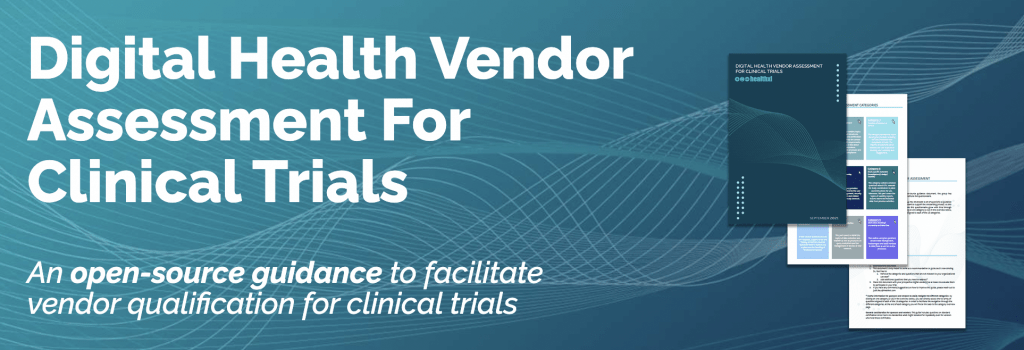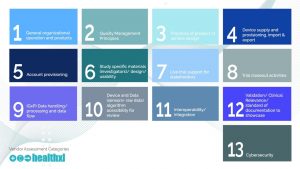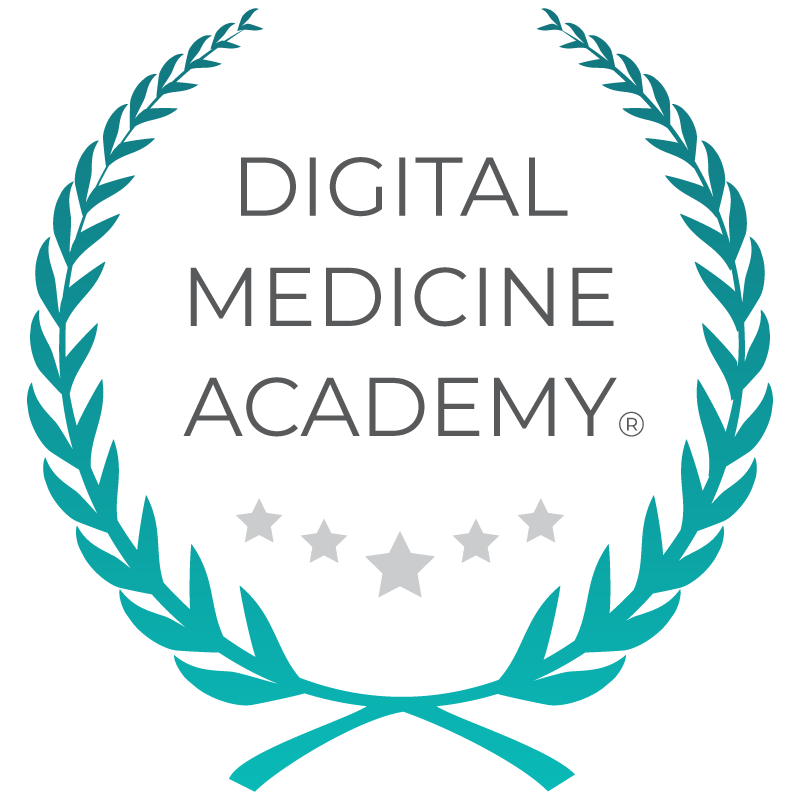
Introducing the Digital Health Vendor Assessment for Clinical Trials
The field of digital medicine continues to experience explosive growth. In drug development, this is reflected in DiMe’s Library of Digital Endpoints, which has increased from 38 sponsors collecting 108 unique endpoints in July 2019 to 69 sponsors collecting 225 unique endpoints in September 2021. Digital health also continues to expand at exponential rates. In radiology, for example, there are over 240 artificial intelligence/machine learning-enabled medical devices that have received 510(k) clearance.
And while things are getting bigger, they aren’t getting any easier. As the field continues to grow, it can be arduous to identify the right partners to optimize a clinical research project. Sponsors are finding themselves inundated with potential collaborators, and it is becoming increasingly difficult for vendors to stand out in an ever-growing ecosystem.
How can sponsors thoroughly and uniformly vet vendors for partnerships in their clinical research endeavors?
How can vendors prepare their body of evidence in a standardized manner and properly prepare for vendor qualification assessments?
Creating a Mutually Beneficial Toolkit
In 2020, HealthXL recognized the opportunity to solve the vendor selection problem for pharma and give vendors a unified vision of what “good” looks like when it comes to partnering with life sciences companies. Then, in January 2021, HealthXL convened multi-stakeholder partners, including The Digital Medicine Society (DiMe), to create a digital health vendor assessment toolkit for clinical trials.

Participants who developed the vendor assessment toolkit for pharma included:
- Erwin De Beuckelaer — Director, Innovation Capabilities at Janssen
- JJ Ferrer — Executive Director, Head of Digital Strategy Oncology at Bayer Pharmaceuticals
- Kris Karson — Co-Founder and CEO, Phebe Health
- Lorcan Walsh — Digital Endpoint Capability Centre Lead, Novartis
- Philip-Moritz Russmeyer — Founder and CEO, FITFILE
- Rachel Chasse — Director of Innovation, DiMe
- Shwen Gwee — VP and Head of Global Digital Strategy, Bristol Myers Squibb
- Tim Ruckh — Associate Director of Devices and Sensors, AstraZeneca
- Eliza Frenz — HealthXL Consultant
- Chandana Fitzgerald — Chief Medical Officer, HealthXL
Prior to launch, the vendor assessment was user tested with:
- Hiromasa Mori — Head of Early Asset Technology, UCB
- Benjamin Vandendriessche — Chief Medical Officer, Byteflies
The vendor assessment toolkit for clinical trials outlines 13 distinct categories typical of the vendor qualification assessment process including considerations that are distinct to digital health.

Example considerations in the vendor assessment toolkit for pharma include:
- How is downtime managed for cloud-based products in use on clinical trials?
- Describe the characteristics of the patient populations where this product has been tested/feedback received from
- How does the vendor account for gaps in any validation work?
- Provide a copy of manuals for study coordinators
- Which algorithms are available as part of a third-party integration (API or SDK)?
- What support do you provide if a hardware component fails during a clinical trial?
A New Blueprint for a Successful Partnership
This new resource helps set realistic expectations of incorporating a digital product or service into a clinical research study. It is through realistic expectations that collaborators can have successful partnerships — this guide helps facilitate these conversations from the onset.
The toolkit also contains a standardized template that allows vendors to prepare and standardize their response package prepared for pharma. This will speed vendor identification and contracting, benefiting both innovators at vendor organization and supporting expedited pharma timelines.
Specific considerations for sponsors
Sponsors should not expect all vendors to address every single item in this toolkit. Both sponsors and vendors should take a fit-for-purpose approach and, in deploying this resource, we encourage users to remove the considerations which do not apply or to add additional questions as needed.
If a vendor is not able to exhaustively respond to an item in this toolkit, it is not necessarily an indication that the vendor is not mature enough to partner. The world of digital health is still evolving, and so are many vendors. Vendor assessment and procurement groups should remain open when reviewing potential vendors, keeping in mind that the best partnerships are a collaboration, not just a transaction-based relationship.
Specific considerations for vendors
Vendors can use this guidance to develop a template for their evidence packages, instead of creating a bespoke bundle de novo for each sponsor. The guidance includes frequently-asked questions during the vendor qualification process, and outlined here to allow vendors a runway to be proactive.
Collaboration is foundational for success
At DiMe, we believe HealthXL’s Digital Health Vendor Assessment for Clinical Trials to be a critically important component of the digital medicine ecosystem. We have proudly included it in The Playbook, the essential guide for successfully developing and deploying digital clinical measures and remote monitoring.
Well-positioned clinical research collaborations are key for making the best products and solutions worthy of patients. We hope this resource can be a tool to strengthen collaboration across the entire field of digital medicine.
_____
At DiMe, our commitment to fully integrating experts from all of the disciplines comprising digital medicine is unwavering. From regulators to white-hat hackers, ethicists to engineers, and clinicians to citizen scientists, we are proud to welcome all experts committed to ensuring that digital medicine realizes its full potential to improve human health. Join us!



